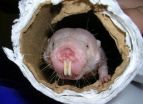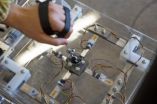(Press-News.org) The human body does a great job of generating new cells to replace dead ones but it is not perfect. Cells need to communicate with or signal to each other to decide when to generate new cells. Communication or signaling errors in cells lead to uncontrolled cell growth and are the basis of many cancers.
At The University of Texas Health Science Center at Houston (UTHealth) Medical School, scientists have made a key discovery in cell signaling that is relevant to the fight against melanoma skin cancer and certain other fast-spreading tumors.
The scientists report that they have discovered why a class of drug called BRaf inhibitors that are widely used to treat melanomas do not always work and most importantly how these drugs may potentially accelerate cancer growth in certain patients. Melanoma, according to the American Cancer Society, accounts for almost 9,000 deaths each year. The scientists' research was published online ahead of the June 5 print issue of Current Biology, which is published by Cell Press.
"This information may aid the development of more effective anti-cancer drugs and better inform the choice of new combinations of drugs," said John Hancock, M.B, B.Chir, Ph.D., the study's senior author, John S. Dunn Distinguished University Chair in Physiology and Medicine, chairman of the Department of Integrative Biology and Pharmacology and interim director of the Brown Foundation Institute of Molecular Medicine for the Prevention of Human Diseases at the UTHealth Medical School.
Growth signals are transmitted from a cell's surface to the nucleus by a chain of proteins that form a signaling pathway. The command for cells to divide to generate new cells is relayed by a chain of four proteins (Ras → BRaf → MEK → ERK). All cells have this pathway and it does an effective job of generating new cells most of time.
Problems happen when a mutation occurs in one of the first two proteins in the chain - both of which lock the signaling pathway in the "on" position. The good news is that doctors have drugs that block signaling from the second protein known as BRaf. These are the BRaf inhibitors, which are successful at treating melanomas with mutant BRaf proteins.
The not-so-good news is that doctors cannot block the signal from the first protein called Ras. Researchers therefore studied in vivo what happens when BRaf inhibitors are applied to human cancer tissues with Ras mutations.
"Surprisingly recent studies found that BRaf inhibitors do not block signaling in melanoma cells with Ras mutations. In fact, the drugs actually enhance the abnormal signaling activity. Our work now describes the mechanism for this seemingly paradoxical enhanced signaling activity," said Kwang-jin Cho, Ph.D., the study's lead author and research fellow at the UTHealth Medical School.
Most melanomas isolated from patients turn out to have either a BRaf or Ras mutation but rarely have both. Ras mutations cause an otherwise normal BRaf protein to stay switched on.
"Our study also emphasizes the importance of genetic testing of melanomas before using BRaf inhibitors. Our study may also help design a better drug," Cho said.
###The study, which is titled "Raf inhibitors target Ras spatiotemporal dynamics," was supported by the Cancer Prevention & Research Institute of Texas.
Hancock and Cho's co-authors from the UTHealth Medical School are: Jin-Hee Park, senior research assistant; Sravanthi Chigurupati, senior research assistant; Dharini van der Hoeven, Ph.D., research fellow; and Sarah J. Plowman, Ph.D., assistant professor.
Other collaborators include: Rinshi S. Kasai, Ph.D., and Akihiro Kusumi, Ph.D., Kyoto University, Japan; and Sonja J. Heidorn, Ph.D., and Richard Marais, Ph.D., Institute for Cancer Research, London.
Discovery in cell signaling could help fight against melanoma
2012-05-11
ELSE PRESS RELEASES FROM THIS DATE:
Economic theory actually works in health care
2012-05-11
WASHINGTON – A study of 7,424 privately insured colon cancer patients found that managed care presence in the market and hospital competition increased the likelihood laparoscopic surgery to treat colon cancer lowered costs, a national team of researchers led by a professor at the George Washington University School of Public Health and Health Services reported in the journal Cancer, May 8, 2012.
Colon cancer is the second leading cause of cancer death in the U.S., and surgical resection is the standard of care. In 2004, there were approximately 134,000 colectomies performed ...
Research reveals novel transport mechanism for large ribonucleoproteins
2012-05-11
WORCESTER, Mass. — The movement of genetic materials, such as RNA and ribosomes, from the nucleus to the cytoplasm is a critical component in a cell's ability to make the proteins necessary for essential biological functions. Until now, it was believed the nuclear pore complex was the sole pathway between the cell nucleus and cytoplasm for these materials. New evidence published in Cell by Vivian Budnik, PhD, Melissa J. Moore, PhD, and colleagues at the University of Massachusetts Medical School, reveals a novel budding mechanism, similar to the process used by some viruses, ...
Long-lived rodents have high levels of brain-protecting factor
2012-05-11
SAN ANTONIO (May 10, 2012) — The typical naked mole rat lives 25 to 30 years, during which it shows little decline in activity, bone health, reproductive capacity and cognitive ability. What is the secret to this East African rodent's long, healthy life?
Scientists from the United States and Israel found a clue. From infancy to old age, naked mole rats are blessed with large amounts of a protein essential for normal brain function.
"Naked mole rats have the highest level of a growth factor called NRG-1 in the cerebellum. Its levels are sustained throughout their life, ...
Helping Hands reaches out to patients with cerebral palsy
2012-05-11
HOUSTON – (May 9, 2012) – With the aid of multiple force sensors and a digital dinosaur, a team of Rice University seniors known as Helping Hands hopes to restore strength and flexibility to the hands and wrists of children with cerebral palsy.
"These kids have a real problem with their hands," said Jenna Desmarais, a senior at Rice majoring in mechanical engineering. "The fingers and wrists are locked into a sort of claw-like position. Even after surgery to correct it, they need physical therapy to get stronger."
The team's rehabilitation device, the Dino-Might, was ...
New twist on ancient math problem could improve medicine, microelectronics
2012-05-11
ANN ARBOR, Mich.—A hidden facet of a math problem that goes back to Sanskrit scrolls has just been exposed by nanotechnology researchers at the University of Michigan and the University of Connecticut.
It turns out we've been missing a version of the famous "packing problem," and its new guise could have implications for cancer treatment, secure wireless networks, microelectronics and demolitions, the researchers say.
Called the "filling problem," it seeks the best way to cover the inside of an object with a particular shape, such as filling a triangle with discs ...
ICU stays for worst asthma drop 74 percent, review finds
2012-05-11
SAN ANTONIO (May 10, 2012) — A review of 30 years of life-threatening asthma cases in a San Antonio intensive care unit found that annual ICU admissions for the condition have dropped 74 percent. The study, by UT Medicine San Antonio physicians who reviewed cases at University Hospital between 1980 and 2010, also showed intubation in the emergency department to help patients breathe did not result in longer hospital stays.
UT Medicine is the clinical practice of the School of Medicine at The University of Texas Health Science Center San Antonio.
Faculty studied inpatient ...
UF study finds logging of tropical forests needn't devastate environment
2012-05-11
GAINESVILLE, Fla. — Harvesting tropical forests for timber may not be the arch-enemy of conservation that it was once assumed to be, according to a new study led by a University of Florida researcher.
Selective logging may be one of the few feasible options left for conserving tropical forests given the huge financial incentives pushing tropical landholders to convert primary forests into cash-generating agricultural plantations.
The report analyzed data from more than 100 studies of tropical forests on three continents that had been harvested for timber. Results ...
CNIO researchers describe a new target for developing anti-angiogenic and anti-tumoral therapies
2012-05-11
Researchers from the Spanish National Cancer Research Centre (CNIO), led by Jorge L. Martínez-Torrecuadrada from the Proteomics Unit, have demonstrated that the antibody-based blocking of ephrinB2, a protein involved in angiogenesis and lymphoangiogenesis, may represent an effective strategy for the development of antiangiogenic and antitumoural therapies.
The results of this study appeared in this month's issue of Blood, the journal of the American Society of Hematology.
CNIO researchers generated highly-specific human antibodies against ephrin-B2 using a phage display ...
Nanotube 'sponge' has potential in oil spill cleanup
2012-05-11
A carbon nanotube sponge that can soak up oil in water with unparalleled efficiency has been developed with help from computational simulations performed at the Department of Energy's (DOE's) Oak Ridge National Laboratory.
Carbon nanotubes, which consist of atom-thick sheets of carbon rolled into cylinders, have captured scientific attention in recent decades because of their high strength, potential high conductivity and light weight. But producing nanotubes in bulk for specialized applications was often limited by difficulties in controlling the growth process as well ...
New report illustrates impact of sequestration to medical research
2012-05-11
The report "Sequestration: Health Research at the Breaking Point," released today by Research!America, demonstrates the damaging consequences of potential automatic spending cuts, or sequestration, to the nation's medical research enterprise and public health, and offers examples on how these cuts would delay scientific discoveries that could lead to new treatments and cures for deadly diseases.
This report provides:
The estimated budget cuts to the National Institutes of Health, the Centers for Disease Control and Prevention, the Agency for Healthcare Research and ...

